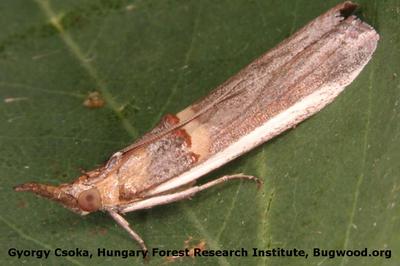Pea Pod Borer
Etiella zinckenella
Insect
In a Nutshell
- Feeding damage to blossom and young pods from the inside, occasionally causing them to fall.
- The build-up of frass causes soft, brown, rotten patches on the surface.
- Split pods show partially or entirely eaten seeds.
Can also be found in
Symptoms
Larvae attack the pods of cultivated legumes including garden pea, pigeon pea, common bean and soybean. Soybean is the preferred host. Small larvae feed on the new blossom and the young pods from the inside, occasionally causing them to fall. Injury to pods is characterized by the presence of entry or exit holes where the larva has damaged the seed vessel. Usually one or two larvae can be found in each pod and the build-up of frass causes soft, brown, rotten patches on the surface. Seeds are either partially or entirely eaten, and if flowers and pods are not available, the larvae will feed on foliage.
Recommendations

Organic Control
Predators include some vertebrates, arthropods and birds. Parasite or parasitoids wasps of the species Bracon platynotae, Perisierola cellularis, and Zatropis tortricidis attack the larvae of the gold-banded Etiella moth, and can have a pronounced effect on its population. Fungal and bacterial diseases can also be used to control the spread of the pest.

Chemical Control
Always consider an integrated approach with preventive measures together with biological treatments if available. This moth is usually not considered a major pest of legumes and often do not deserve any course of action. However, some insecticides formulations can be used as foliar sprays.
What caused it?
The damage is caused by the larvae of the moth Etiella zinckenella, a pest with worldwide distribution. Adult moths are nocturnal and have a light brown body with a bulging head and two long protuberant antennae. Forewings are brown-grayish with a characteristic glittering aspect and a white stripe that runs along the fore edge. A golden-orange band crosses the wing on both sides, thereby the common name "gold-banded Etiella moth". Hindwings are light gray, with dark venation and dark, long fringe. Females lay their eggs on blossom or on green fruits and larvae live inside the fruit, eating away the seeds, and easily passing from one bean to another. They are pale green to green with a brownish tinge and and orange head crowned with a black V shape and four black dots. Larva fall to the soil and overwinters within a cocoon in soil at a depth of 2-5 cm and emerge as adults in spring.
Preventive Measures
- Use tolerant varieties if available.
- Monitor fields for signs of the pest (egg masses, caterpillars, damage).
- Remove infested flowers, pods or plant parts by hand.
- Keep up an optimum level of nitrogenous fertilizer.
- Optimize the drainage of the field, as flooding increases the chances of an infestation.
- Use traps to monitor or mass-catch the moths.
- Build perches and open space for birds that will feed on the larvae.
- Apply a good weeding program in the field and surrounding area.
- Control the use of broad-range insecticides, as this can affect beneficial insects.
- Remove plant residues or volunteer plants after harvest.
- Follow crop rotation with non-susceptible crops.



